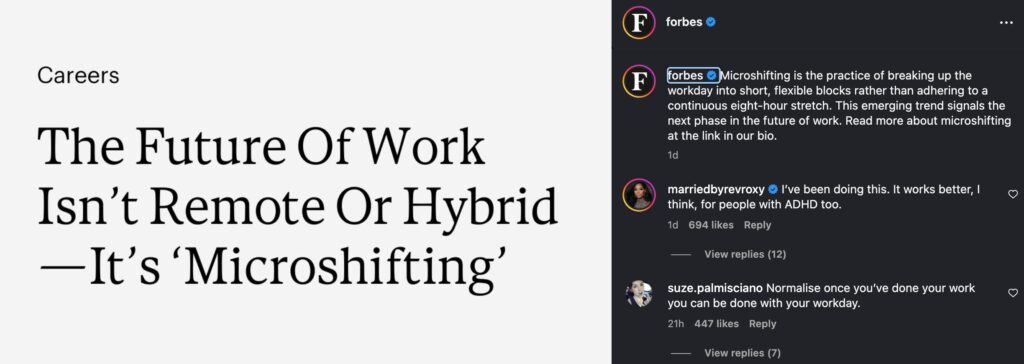- Last Week I Had a Viral LinkedIn Post — But Why? (And What TA Folks Can Learn From It) - December 8, 2025
- Job Description Process Improvement: How One Workflow Fix Saved 1,200 JDs from Chaos - December 4, 2025
- Affordable Job Description Management Software (That Still Do the Job Right) - November 19, 2025
The 9-to-5 is dead. And the future of job descriptions better reflect it—or you’ll lose the people who need (and deserve) more flexibility.
This idea hit home for me when my good friend and Ongig writer, Sarah Akida, sent me an Instagram post about “microshifting.” It led to this Forbes article that nailed exactly what I (and so many others) have been feeling. The 9-to-5 structure doesn’t work for everyone, and this gave it a name.

What Is Microshifting?
Microshifting is the practice of breaking your workday into small, flexible chunks instead of clocking a traditional 8-hour block. It’s the freedom to work when your brain works best, or when your toddler naps, or after your mom’s doctor appointment. You do the work, just not all at once.
One Instagram comment summed it up perfectly:
“Work, do chores, work, run an errand, work, stare into space for a bit, work, take my corgi out.”
It’s human. It’s modern. And it works.
Why It Matters for Job Descriptions
We’ve written thousands of job descriptions, and one of the most overlooked sections is the one about “work hours.” It often says things like “standard business hours” or “Monday–Friday, 9–5.” And just like that, you lose out on incredible candidates—working parents, caregivers, folks with ADHD, and others who simply don’t thrive in a rigid schedule.
Instead, your job description can become a signal of trust and flexibility. Say things like:
- “We support microshifting—work when you’re most productive.”
- “We care about outcomes, not hours.”
- “Need to pick up your kids or take a midday break? Totally fine.”
If you want to attract top talent, say what you mean. People read between the lines. Don’t make them guess if your company really supports flexibility.
This Is Personal (and Powerful)
One comment that stuck with me:
“My husband and I both have careers that allow us to microshift…we’re probably more effective because we can make time for our children and our health.”
This isn’t just about productivity. It’s about humanity. And if your job descriptions aren’t reflecting that shift, your benefits might sound fluffy.
What to Update in Your JD
- Benefits section: Add a bullet that says, “Flexible scheduling through microshifting encouraged.”
- About us: Share a sentence about how your company supports people working in the way that works best for them.
- Work hours: Avoid phrases like “9 to 5 required” unless it truly is. If flexibility exists, name it.
Why Microshifting Matters Right Now
The caregiving crisis isn’t going away. Neither is burnout. And workers are done organizing life around work—they want the reverse. A Forbes article cited 62% of employees are caring for kids, and another big slice are caring for parents. Microshifting gives them space to show up for both life and work, without feeling like they’re failing at either.
And it’s not just parents. Poly-employed workers. People with multiple gigs. Folks juggling therapy, vet appointments, life. They’re already microshifting. Are your job descriptions keeping up?
3 Simple Ways to Lead with Microshifting
- Change your job description language. Add just one line that says: “We support microshifting—work in a way that fits your life.”
- Model it from the top. If leadership embraces it, shout it out. Share it in your employer brand stories, your hiring pages, your JDs.
- Trust your people. Flexibility without trust is just a policy. Make sure your culture backs it up.
Microshifting = Better Hiring
The best part? Microshifting isn’t just the right thing to do. It’s also a better way to work. Candidates who feel trusted and supported are more likely to apply—and stay. Your job descriptions are one of the first places they look for those signals.
So next time you’re updating your JDs, ask yourself: am I writing for humans, or for a time clock?
Why I Wrote This
At Ongig, we help companies write modern job descriptions every day. When Sarah Akida shared the concept of microshifting with me, it clicked. This is the future of work—and your job descriptions should reflect that. If you want help saying it better, request a demo and we’ll show you how Ongig can help you hire in a more human way.
FAQs
What is microshifting?
Microshifting is the practice of working in short, flexible bursts instead of a continuous 9–5 schedule.
Is microshifting the same as flex time?
Nope. Flex time lets you shift your day. Microshifting lets you work in intervals throughout the day based on energy, needs, and focus.
Who benefits most from microshifting?
Parents, caregivers, people with ADHD, poly-employed folks, and honestly—anyone who doesn’t thrive in rigid hours.
How can I add microshifting to my job descriptions?
Include a clear sentence about flexible scheduling. Avoid vague terms like “work-life balance” and be specific.
Does Ongig help with this?
Yes! Ongig helps you build inclusive, clear, and modern job descriptions—flexibility and all. Request a demo to see how.
